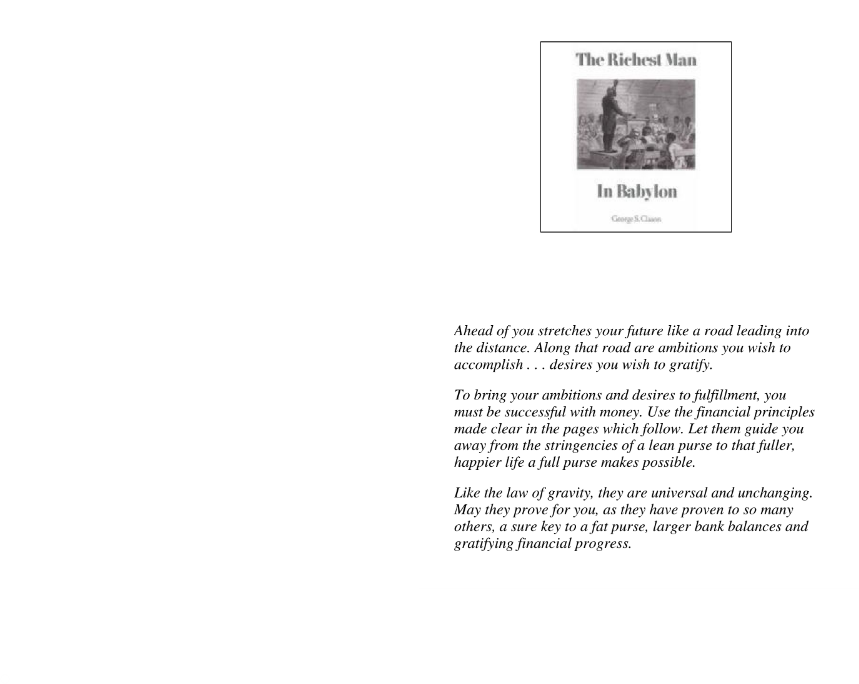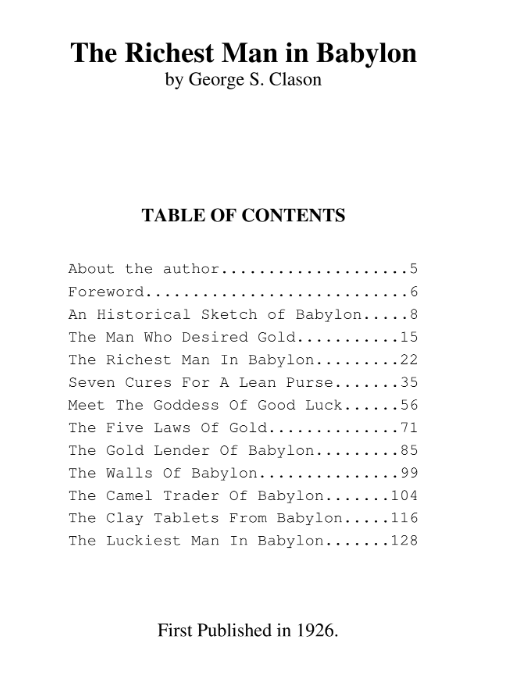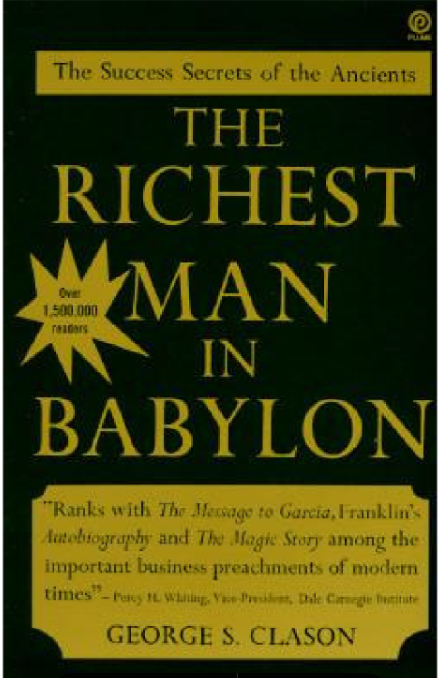


GEORGE SAMUEL CLASON was born in Louisiana, Missouri, on November 7, 1874. He attended the University of Nebraska and served in the United States Army during the Spanish-American War. Beginning a long career in publishing, he founded the Clason Map Company of Denver, Colorado, and published the first road atlas of the United States and Canada. In 1926, he issued the first of a famous series of pamphlets on thrift and financial success, using parables set in ancient Babylon to make each of his points. These were distributed in large quantities by banks and insurance companies and became familiar to millions, the most famous being “The Richest Man in Babylon,” the parable from which the present volume takes its title.
These “Babylonian parables” have become a modern inspirational classic. Our prosperity as a nation depends upon the personal financial prosperity of each of us as individuals. This book deals with the personal successes of each of us. Success means accomplishments as the result of our own efforts and abilities. Proper preparation is the key to our success. Our acts can be no wiser than our thoughts. Our thinking can be no wiser than our understanding. This book of cures for lean purses has been termed a guide to financial understanding. That, indeed, is its purpose: to offer those who are ambitious for financial success an insight which will aid them to acquire money, to keep money and to make their surpluses earn more money. In the pages which follow, we are taken back to Babylon, the cradle in which was nurtured the basic principles of finance now recognized and used the world over.
In the pages of history there lives no city more glamorous than Babylon. Its very name conjures visions of wealth and splendor. Its treasures of gold and jewels were fabulous. One naturally pictures such a wealthy city as located in a suitable setting of tropical luxury, surrounded by rich natural resources of forests, and mines. Such was not the case. It was located beside the Euphrates River, in a flat, arid valley. It had no forests, no mines—not even stone for building. It was not even located upon a natural trade-route. The rainfall was insufficient to raise crops. Babylon is an outstanding example of man’s ability to achieve great objectives, using whatever means are at his disposal. All of the resources supporting this large city were man-developed. All of its riches were man-made.
As a city, Babylon exists no more. When those energizing human forces that built and maintained the city for thousands of years were withdrawn, it soon became a deserted ruin. The site of the city is in Asia about six hundred miles east of the Suez Canal, just north of the Persian Gulf. The latitude is about thirty degrees above the Equator, practically the same as that of Yuma, Arizona. It possessed a climate similar to that of this American city, hot and dry. Today, this valley of the Euphrates, once a populous irrigated farming district, is again a wind-swept arid waste. Scant grass and desert shrubs strive for existence against the windblown sands. Gone are the fertile fields, the mammoth cities and the long caravans of rich merchandise. Nomadic bands of Arabs, securing a scant living by tending small herds, are the only inhabitants. Such it has been since about the beginning of the Christian era.
Many scientists consider the civilization of Babylon and other cities in this valley to be the oldest of which there is a definite record. Positive dates have been proved reaching back 8000 years. An interesting fact in this connection is the means used to determine these dates. Uncovered in the ruins of Babylon were descriptions of an eclipse of the sun. Modern astronomers readily computed the time when such an eclipse, visible in Babylon, occurred and thus established a known relationship between their calendar and our own. In this way, we have proved that 8000 years ago, the Sumerites, who inhabited Babylonia, were living in walled cities. One can only conjecture for how many centuries previous such cities had existed. Their inhabitants were not mere barbarians living within protecting walls. They were an educated and enlightened people. So far as written history goes, they were the first engineers, the first astronomers, the first mathematicians, the first financiers and the first people to have a written language.
By means of an elaborate drainage system they reclaimed an immense area of swamp land at the mouths of the Euphrates and Tigris Rivers and put this also under cultivation. Herodotus, the Greek traveler and historian, visited Babylon while it was in its prime and has given us the only known description by an outsider. His writings give a graphic description of the city and some of the unusual customs of its people. He mentions the remarkable fertility of the soil and the bountiful harvest of wheat and barley which they produced. The glory of Babylon has faded but its wisdom has been preserved for us. For this we are indebted to their form of records. In that distant day, the use of paper had not been invented. Instead, they laboriously engraved their writing upon tablets of moist clay. When completed, these were baked and became hard tile. In size, they were about six by eight inches, and an inch in thickness.


